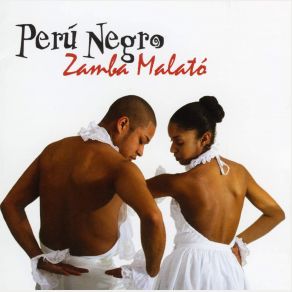Zamba Malato
Download links and information about Zamba Malato by Peru Negro. This album was released in 2008 and it belongs to World Music, Latin genres. It contains 12 tracks with total duration of 51:57 minutes.

|
|
|---|---|
| Artist: | Peru Negro |
| Release date: | 2008 |
| Genre: | World Music, Latin |
| Tracks: | 12 |
| Duration: | 51:57 |
| Buy it NOW at: | |
| Buy on iTunes $9.99 | |
| Buy on Amazon $9.49 | |
Tracks
[Edit]| No. | Title | Length |
|---|---|---|
| 1. | Una Negra y un Negro | 4:05 |
| 2. | Zamba Malato | 4:26 |
| 3. | Canete | 3:14 |
| 4. | Que Tiene Miguel | 6:09 |
| 5. | Festejo de Ritmo | 3:39 |
| 6. | Golpe e' Tierra | 4:38 |
| 7. | Toro Mata | 5:04 |
| 8. | Afro | 4:33 |
| 9. | Bailaras | 3:53 |
| 10. | Pancha Remolino | 3:47 |
| 11. | Su Majestad el Cajon | 3:58 |
| 12. | Cajones | 4:31 |
Details
[Edit]Peru Negro was unknown in the United States until 1995, when David Byrne's Luaka Bop label released The Soul of Black Peru compilation. The album tracks by Peru Negro were marked by the relentless rhythms of the cajón, a specially constructed wooden box that produced a booming bass drum-like sound, strong melodies, and exuberant call and response vocals that echoed the music's African, Latin, and European origins. It introduced North Americans to a group that was already a sensation on the European and Latin American festival circuit.
Afro-Peruvian music owes part of its unique character to events that happened 200 years ago, thousands of miles to the north. When Haitian slaves defeated the French and created the Republic of Haiti in 1803, the Spanish government in Peru rightly believed the common language of Haitian slaves aided their liberation struggle. To dilute African culture, the Spanish in Peru imported slaves from all over Africa as well as Catholic, Spanish speaking slaves from Cuba and Columbia. They also outlawed the drum. Deprived of their ancient traditions, the blacks of Afro-Peru created a new one. The banned drums were replaced by new percussion instruments. The cajón — originally a fruit crate — is now a carefully designed rectangular box, with a booming low end. A player sits on the box and strikes it with his hands. The cajita is a lidded box, used in Catholic churches for collections. The lid is snapped open and closed and the side of the box is played with a small stick. It sounds like the Cuban clave. The quijada de burro is a donkey jawbone with the teeth loosened, the sound is part shakere, part guiro. Together the create a syncopated pulse that's unique to Afro-Peru although there are unmistakable influences of Cuba and flamenco in the sound of today's Peru Negro. "Una Negra U un Negro" is a festejo with the chorus singing in unison about the wedding night. The refrain says "Eso no se dice..." — "That cannot be told", an ingenuous way of being sensual and discreet at the same time. The exuberant vocals play off the propulsive guitar and bassline. "Festejo de Ritmo," as you might expect, is a chance for the group's percussionists to show off. Peru Negro incorporates bongos and congas into their arsenal for a sound that echoes Afro-Peru, Cuba, and Africa. "Cajones," the hidden thirteenth track, showcases the bands three cajón players to demonstrate the varied tones and timbres they can get from the instrument. "Zamba Malató" is a lando, a syncopated dance of seduction, driven again by the group vocals and dynamic guitar work of Frank Perez. "Toro Mate" is perhaps the most famous lando of Afro-Peru; Celia Cruz made it an international hit with her recording. Monica Dueñas lays down a smoldering vocal as the percussionists slowly increase the song's tempo to bring the song to a climax. "Pancha Remolino" is another festejo with a saucy give and take between vocalists Monica Dueñas and Marco Campos. In Afro-Peruvian music, the main interplay is the give and take between the dancers and percussionists, which makes seeing Peru Negro live a must, but the music here is propulsive enough to carry its own weight. ~ j. poet, Rovi